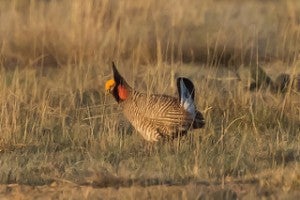
2015 marked the end of a five-year drought, bringing relief to the parched prairie region. But climate impacts like drought and wildfires are only expected to increase in the future, threatening lesser prairie-chicken recovery efforts. Credit: Lesser Prairie Chicken via photopin (license)
Recent media reports have touted population rebounds for the lesser prairie-chicken – up 25 percent from last year. That’s great news for the bird, which was nearly wiped out in recent years as booming oil and gas industries encroached on the bird’s range across Texas, Kansas, Oklahoma, Colorado and New Mexico.
The U.S. Fish and Wildlife Service listed the bird as “threatened” in March 2015, at the same time that the five states embarked on a conservation plan of their own. The plan was officially assembled and endorsed by the five members of the Western Association of Fish and Wildlife Agencies (WAFWA).
Now that bird numbers are up, WAFWA is claiming success – attributing the chicken’s rebound to effective implementation of their Lesser Prairie-Chicken Rangewide Conservation Plan (RWP). Certainly that program has provided some benefit, but the key question is whether the program has been a big enough boost to set the lesser prairie-chicken on a path to recovery. Read More









